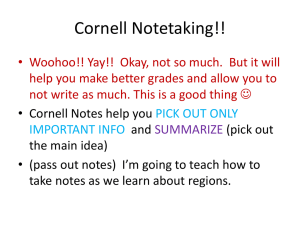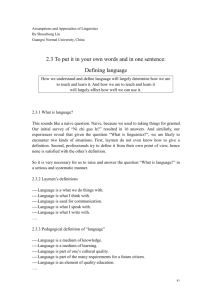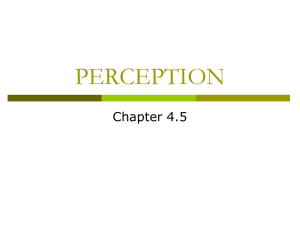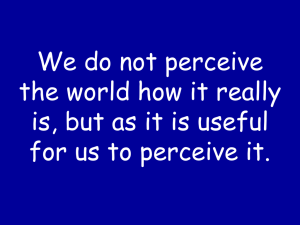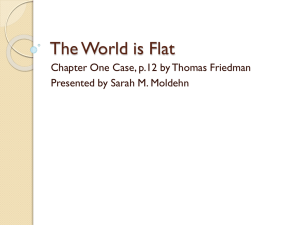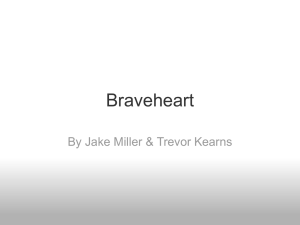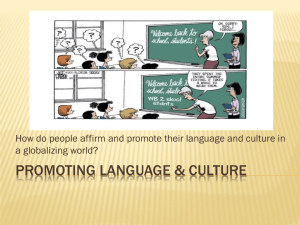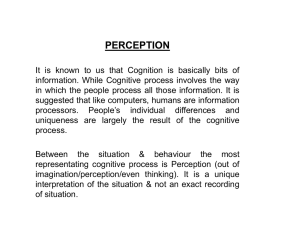PPT
advertisement
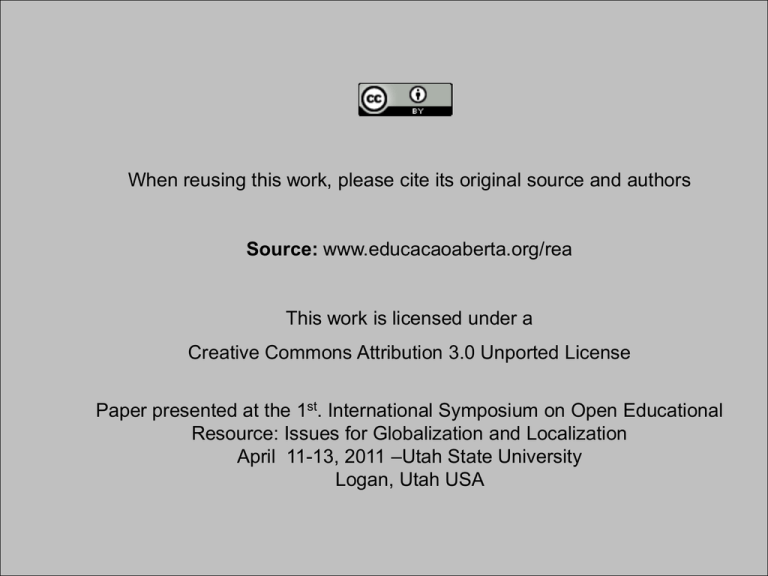
When reusing this work, please cite its original source and authors Source: www.educacaoaberta.org/rea This work is licensed under a Creative Commons Attribution 3.0 Unported License Paper presented at the 1st. International Symposium on Open Educational Resource: Issues for Globalization and Localization April 11-13, 2011 –Utah State University Logan, Utah USA Cultural Affordances, Learning Objects, and the Localization/Globalization Dilemma. Richard P. West, Phd, Matthew J. Taylor,Phd, and Boyd Teemant, MS. Gibson’s Perceptual Learning • Perceptual Learning-Ability to perceive improves with experience -Acquisition of new knowledge based on the improved ability to perceive • Perceptual development is an important part of cognitive development • Learning and increasing conceptual sophistication comes from increased ability to detect meaningful aspects of external stimuli (Gibson, 1955). Gibson’s Perceptual Learning • Learning to perceive---perceiving to learn – One developmental process is learning how to perceive, a large part of this for Gibson is experience – Another aspect of learning is the idea that the better we perceive, distinguish, discriminate differences, the better we learn, and learn in new meaningful ways • Differentiation of discrete properties – Perception improves because we detect more aspects, features and nuances of the complex stimuli in the environment (not necessarily because we are rewarded for the new perceptions and differentiations) Gibson’s Perceptual Learning • Differentiation of discrete properties – Perception improves because we detect more aspects, features and nuances of the complex stimuli in the environment – At birth a child can see between 9 and 30 inches, as perception improves, differentiation improves. Social Smile at 6 months, etc. Gibson’s Perceptual Learning • Affordances-“the relationship between an object and an organism …affordances [are] one of the primary perceivable aspects of the environment, … affordances may be among the first properties of the environment differentiated in perceptual development” (Pick, 1992). Relationship between aspects of environment and characteristics and abilities of the organism. – A child may be riding his or her bike and wanting to cross the street, hopefully the child does not need to get hit by a car a few times to learn how fast to pedal – Performance can improve, (ability to complete task and perceive better) occurs not necessarily because of learning a new way but increased ability to perceive How do we think about this in terms of culture? • • • • • • Language Direct Experience Indirect Experience Sub-cultural Membership Modality Localization/Globalization Language • Language is a large part of how we perceive the world. We learn language and learn to understand the world differently, and as we learn new ideas we seek to express them through language. • Vygotsky (1978) suggested that the cultural line of development (usually after age 2) is most strongly influenced by language. • Others suggest that “language and culture are intimately linked” (DeCapua & Wintergerst, 2010, p. 23). • Whorf’s hypothesis (1956) [linguistic relativity] was that thoughts are so influenced by language that language actually determines thought. Most people disagree with Whorf and modify this to accept that language has a strong influence thoughts and perceptions. • We perceive and learn to perceive language (think about learning your second language). Language • Wrong Language – Literally, the object includes a language foreign to the user (e.g., Chinese to a native Portuguese-only speaker or a native English-only speaker). Close Language – The object includes a language that is foreign to the user, but relatively understandable (e.g., Spanish to a native Portuguese-only speaker). Poor Language – The object uses words from the user’s primary language, but their meaning and organization make them barely useful (e.g., Babel fish translation). – Chevy Nova (no va) was notoriously a bad translation and did not sell well in Spanish Speaking countries. – In German, "Come alive with Pepsi" was translated clumsily as "Come out' of the grave with Pepsi!" "Body by Fisher" came out as "Corpse by Fisher." In another case, "car wash" became "Car '*- enema." – One U.S. airline advertised in Brazil that its 747s had rendezvous lounges. To Americans and Frenchmen, rendezvous is one thing, in Brazil a very different meaning. Language • Local Language - The object is written in the user’s primary language, but includes reference to local places or local people not known to the user, or colloquial phrases not understood by the user. Universal Language – The object is well written in the user’s primary language and is free of Local Language. - CSF’s Indicators of School Quality Survey, translated/back translated into Spanish but tried to get it free of any regional language to engage parents from multiple nationalities that speak Spanish. Direct Experience (age) • Cohort Effect-shared experience usually defined by age. Different age groups share different meanings for events because they experienced and perceived these events together. As individuals move through life together they experience/perceive the same events in history; WWII, John F. Kennedy, Fall of the Berlin Wall, Twin Towers, etc. • Precise Age – The object references persons (e.g., one hit wonder), places (e.g., club 54), or things (e.g., Boogie board), or uses language that only people of a specific age would understand. Old Enough – The object references persons (e.g., old movie star), places (e.g., route 66), or things (e.g., gas wars), or uses language that only users of a certain age or older would understand. Direct Experience • Young Enough - The object references persons (e.g., current Disney star), places (e.g., the hood), or things (e.g., Bluetooth), or uses language that only users of a certain age or younger would understand. Age Appropriate - The object references persons, places, or things, or uses language that might be inappropriate for users of a young age. Universal Age - The object references persons, places, or things, or uses language that is ageless and appropriate for users of all ages. Indirect Experience (education) Advanced – The object references concepts or vocabulary that would exclude most readers without an advanced degree (e.g., statistics). Esoteric – The object references concepts or vocabulary that would exclude most readers without an esoteric knowledge (e.g., dog breeding, or other specific domains). High School – The object references concepts or vocabulary that would exclude most readers without a high school diploma (e.g., World History). Literate – The object uses written language. No Education – The object is free of written language (e.g., images, movies, audio files). – some people might allow Vicarious Learning, Modeling, and Cultural Efficacy here as well (Bandura, 2002). – Culture teaches us which models are more salient. Sub-cultural Membership Ethnic – The object references persons, places, things, or activities that are unique to any ethnic cultural not understood by the user. Religious – The object references persons, places, things, or activities that are unique to any religious culture not understood by the user. Political – The object references persons, places, things, or activities that are unique to any political cultural not understood by the user. Social – The object references persons, places, things, or activities that are unique to any social cultural not understood by the user. Universal Culture – The object is free of ethnic, religious, political, or social cultural references not understood by the user. Modality Creating or bringing the object into a modality that can accommodate one’s ability to perceive. Text only – Object is not accessible to the blind. Audio file – Object is not accessible to the deaf. Still image – Object is not accessible to the blind. Video – Object might have limited access to the blind and requires captioning for deaf. Universal – Object meets universal accessibility requirements. Localization/Globalization • Creating learning objects and providing affordances includes consideration and debate about how much to bring object into the available perceptions of the target audience… • And how much to teach the target audience to perceive in a more global way or with new affordances. • When is localization important? • When is globalization important?
